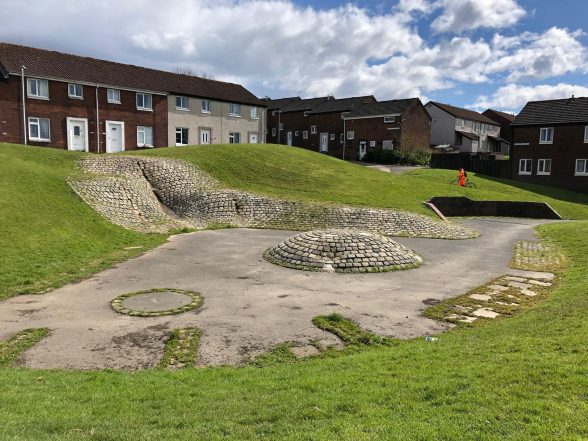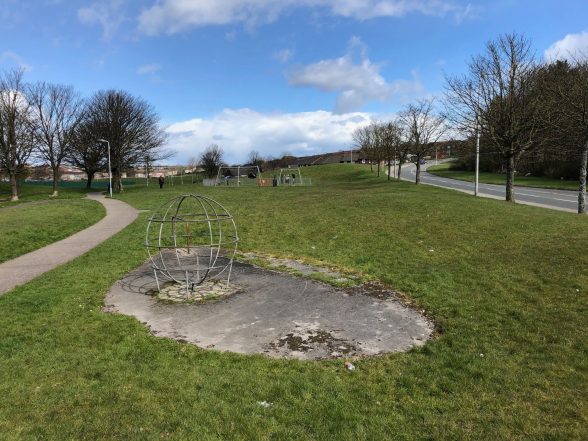This website uses cookies
This website uses cookies to enable it to function properly and to analyse how the website is used. Please click 'Close' to accept and continue using the website.



Photo: Joy Burgess, Manchester School of Architecture
The removal during the lock down of seven slides from a pioneering Mary Mitchell play area in Workington, Cumbria, has prompted the Twentieth Century Society to step in to safeguard it, submitting the landscape for entry onto Historic England’s Historic Parks and Gardens register.
Joy Burgess, who is researching the work of female landscape architects in post-war Britain for a PhD at the Manchester School of Architecture in collaboration with Historic England, recently identified the landscape as being the work of Mary Mitchell, a leading landscape architect specialising in the design of playgrounds in the post-war period. This is an exciting discovery as few of Mitchell’s landscapes are known to survive.
The Society considers the Mitchell-designed play areas at the Moorclose housing estate to be a designed landscape of great significance, both locally and nationally. It could not have been included in Historic England’s Post-War Landscapes thematic survey of 2020 because it had not been discovered yet.
C20 Society caseworker Coco Whittaker said: “We understand from Joy that the slides from the ‘Seven Slides’ play area have been removed, marking the start of a process to replace the existing landscape. We now urge the council to take note of the significance of the landscape and to move to protect it. We would be happy to meet with the housing association and council to discuss how best to go about this.”
Joy commented: “It has been so exciting to discover one of Mitchell’s housing landscapes that still remains. Her design, especially the ‘Seven Slides’ play space, has become a much loved landmark within the community. This is a great testimony to the success and longevity of Mitchell’s scheme as well as her ideas around play.”

Photo: Joy Burgess, Manchester School of Architecture
Dr Luca Csepely-Knorr, Reader in Architecture at the Manchester School of Architecture, said: “I am delighted that the C20 Society moved to safeguard the future of this very important post-war designed landscape. Landscapes of housing estates were key in creating a more equal distribution of green space in the post-war period, and children’s play areas were crucial part of them. Mary Mitchell’s design in Workington is a masterpiece from this period, uniting excellence in landscape design and detailing, with up-to-date theories about children’s welfare and play. Her playgrounds, together with other spaces for children from the period are hugely at risk, and I hope raising awareness of this project will help safeguarding the future of other examples.”
Mitchell (1923-1988) was a key part of the post war adventure playground movement led by the landscape architect Lady Allen of Hurtwood. Lady Allen’s book, Planning for Play (1968), emphasised the need for play areas at housing estates as a means of “keeping alive, and of sustaining, the innate curiosity and natural gaiety of children”. Mitchell’s work, particularly Camp Hill at Nuneaton of 1966, featured significantly in Planning for Play.
The Moorclose 6 Housing Development was built for the Allerdale District Council to designs by Johnston & Wright. Mitchell was commissioned in 1975 to work on the later ‘Phase 6’ of the housing development which appears to have been built in 1981/2.
At Moorclose, Mitchell created land forms and set slides into slopes and cobbles. Burgess points out that one of Mitchell’s signature design styles was her attention to detail with ground modelling, which you see clearly at the Moorclose 6 Development. One of Mitchell’s metal globes, a play object she often incorporated into her landscape schemes, survives in-situ at Moorclose.
In Landscape by Design, Tony Aldous and Brian Clouston observe that “few consultants have made more of an impact on the profession and its clients’ thinking in a particular area of landscape design than Mary Mitchell in the field of children’s playgrounds.”
Mitchell trained at the Royal Horticultural Society’s garden at Wisley in Surrey and Royal Botanic Garden in Edinburgh before being articled to Richard Sudell, known for driving the creation of the Institute of Landscape Architects. In 1946-7, she studied landscape design at the School of Planning in Gordon Square, London, and in 1951 studied Architecture at Manchester Municipal School of Art. She worked in private practice in Johannesburg and Zurich before becoming Landscape Architect to Stevenage New Town Development Corporation. In 1957 she became the first landscape architect to be employed by the City of Birmingham Architects Department and established herself as a pioneering designer of playgrounds. She set up her own private practice in 1962 at 38 Carpenter Road, Edgbaston. In 1965 Mitchell became consultant landscape architect to Blackburn and the play areas she created here have been widely published and celebrated, including in the Twentieth Century Society’s 100 20th-Century Gardens and Landscapes book. She was elected an associate of the Institute of Landscape Architects in 1955 and became a fellow in 1963.
Anyone wanting to support C20’s application (reference number 1475947) should write to ApplicationsNorth@HistoricEngland.org.uk.

Become a C20 member today and help save our modern design heritage.